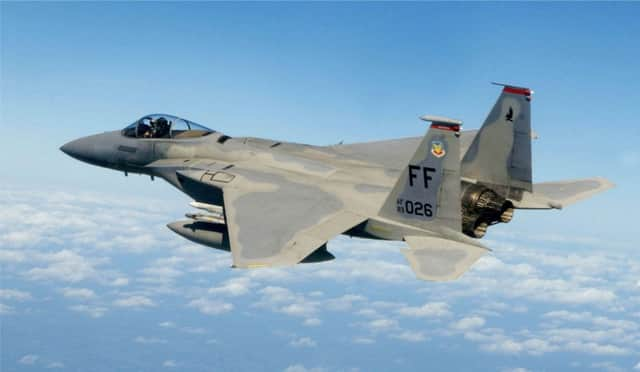Passenger plane, F15s in near miss above Montrose


There was also the possible use of electronic jamming, an official probe heard.
The UK Airprox Board, which investigates near misses said “the potential for a very serious incident had been present.”
Advertisement
Hide AdAdvertisement
Hide AdA Boeing 737 passenger plane was above Montrose on April 7 - coinciding with Europe’s biggest war games, Joint Warrior - which are held twice-a-year, the second is currently being staged in Scotland.
The three F15s were on a flight - each known as TREK - based out of RAF Lakenheath in Suffolk.
In its report to the board, HQ Air Command said the incident was a “very complex situation, in which communications-failure resulted in a very high workload across multiple Air Traffic Control agencies, and an Airprox with a civilian airliner.”
The United States Air Forces in Europe said the events “were a matter of communication breakdown” between the controllers and the military flight.
It said the communication problems seemed to emanate from the Fighter Marshaller based at RAF Scampton in Lincolnshire - call sign Blackdog - and “the possible jamming” in the exercise, it said.
The UK Airprox Board said the pilots of the three F15s lost air traffic control communication.
“They made several calls on the Swanwick Military frequency which were not answered due to high controller workload. Because the aircraft were non-Reduced Vertical Separation Minimum approved, and coordination had not been effected, the minimum separation required from the B737 was 5 nautical miles horizontal and/or 5000ft vertical.
“This was not achieved with any of the F15s. The turn given by the Montrose controller, when avoiding other traffic, decreased the lateral spacing between the B737 and the F15s, and the B737 subsequently entered an active Danger Area.
Advertisement
Hide AdAdvertisement
Hide Ad“The radar recording showed the closest point of approach (CPA) between the B737 and the third F15 was 0.7nm horizontal. The CPAs from the other two aircraft were respectively 1.6nm/3900ft and 1.4nm/4100ft.
“The Board first discussed the actions of the B737 pilot. It was noted that the pilot had initially been given a left turn heading 315°, which was followed shortly afterwards with an avoiding action, immediate right turn, heading 090°. The pilot queried the revised heading which was then confirmed by the Montrose controller.
“The Board could understand the pilot’s uncertainty in being given such a large change of heading, especially as he had been given a turn in the opposite direction just previously, but were very concerned that the pilot had thought to question the ‘immediate’ call to turn rather than initiate the turn and then seek confirmation afterwards.
“As for the F-15 crews, the Board were concerned that TREK 11 Flight had continued operating in Class C airspace for 18 mins or so without established two-way communication with ATC; the Board wondered what clearance, if any, they had received, or thought they had been given.
“The apparent lack of a robust recovery plan for the F-15s returning to base after their exercise, with contingency considerations and fuel reserves included, was considered to be a contributory factor to the Airprox.
“As for the Tac (traffic aircraft) 2 controller, the Board had significant sympathy for the situation in which she found herself. Amongst a sea of confusion with callsigns, short-notice handovers and protracted attempts to achieve coordination with Montrose, the unexpected free-call by TREK 11 Flight, on the ‘protected’ frequency, tipped her over the edge as she quickly became overloaded and ended up simply reacting to events whilst attempting to gain understanding and situational awareness.
“The Board considered that a number of issues were pertinent as possible causes (of the Airprox), including the loss of communication with Blackdog; lack of a robust recovery plan by the F15s; their continued track southbound in Class C airspace without a clearance; their use of the incorrect frequency; and the saturation of the Swanwick Military Tac 2 controller.
“As to the degree of risk; although the potential for a very serious incident had been present, it was considered that effective and timely actions, albeit only by the Montrose controller, had been taken to prevent the aircraft colliding.”
The F15 formation also did not use Swanwick Initial Contact Frequency.
The Board listed the degree of risk as C.